Defence Research and Development Canada News
| Thumbnail | Description |
|---|---|
 |
Research and development supports a safer and more secure CanadaMarch 7, 2025 Science and technology developed and funded through the Canadian Safety and Security Program (CSSP) is helping Canada anticipate, prevent, mitigate, prepare for, respond to, and recover from natural disasters, serious accidents, crime, and terrorism. |
 |
DRDC investigates virtual reality for moral decision-making training in military operationsJanuary 29, 2025 Making decisions under pressure is difficult, especially when the consequences can be dire. Defence Research and Development Canada’s Toronto Research Centre, in collaboration with researchers from the National Research Council of Canada’s Medical Devices Research Centre, have begun to address this challenge for current and future military operations by evaluating the effectiveness of virtual reality training. |
 |
Satellite trio will test new systems of monitoring in the High ArcticJanuary 16, 2025 Three recently launched research and development (R&D) microsatellites, known as the Gray Jay Pathfinder mission, will orbit in high latitudes to evaluate new technologies to provide situational awareness in the Arctic Circle for the Canadian Armed Forces (CAF). |
 |
Half a year in Ukraine: Defence scientist worked directly with Ukrainian military members and volunteers innovating on the front lineJanuary 6, 2025 Innovation is moving at the pace of necessity on the frontline in Ukraine, as new technology and countermeasures are rapidly developed and deployed. In 2024, Defence Research and Development Canada (DRDC) defence scientist Marie-Pierre Raymond supported Ukrainian military innovation during an almost seven-month deployment as a science advisor in Kyiv, Ukraine, as part of Operation UNIFIER. |
 |
Research team swells understanding of coastal flooding risksDecember 23, 2024 Nearly 6.1 million people live within 20 kilometres from the marine coasts of Canada. Funding from the Canadian Safety and Security Program (CSSP) is helping Canadian communities better understand risks from storm surge, sea-level rise and tsunamis to develop mitigation strategies. |
 |
Arctic research and developmentVideo | December 23, 2024 Defence Research and Development Canada is advancing science and technology to enable and inform Canadian Armed Forces operations in the Arctic, defend Canada, improve security and support NORAD modernization. |
 |
DRDC demonstrates satellite capabilities during Op NANOOKDecember 12, 2024 For the second year in a row, Defence Research and Development Canada (DRDC), supported by the Canadian Forces Intelligence Group, planned and completed a Space-Based Intelligence, Surveillance and Reconnaissance (SB ISR) scientific experiment during Operation NANOOK – TUUGAALIK (NA-TU) and NANOOK - NUNAKPUT (NA-NK) 2024. |
 |
Minister Blair congratulates successful Canadian innovators joining the 2025 NATO DIANA cohortDecember 12, 2024 The North Atlantic Treaty Organization’s (NATO) Defence Innovation Accelerator for the North Atlantic (DIANA) has announced the successful innovators in 2024’s competitive challenges. These firms – seven of whom are Canadian – will be joining NATO DIANA’s 2025 cohort of innovators. |
 |
The Canadian Joint Warfare Centre coordinates the CAF’s participation in Bold Quest 2024December 9, 2024 Bold Quest (BQ) 24 Island Marauder took place from 7 October to 8 November 2024, at Camp Lejeune, North Carolina. Sponsored by the United States Joint Staff (USJS), this annual event is a multinational collaboration where countries, services, and programs jointly develop, demonstrate, and analyze capabilities. |
 |
DRDC continues to AMAZE with Arctic emissions reduction researchDecember 4, 2024 The Arctic can be a challenging place for technology, with remoteness, harsh weather and freezing temperatures adding a layer of complexity. Add to that the Canadian Armed Forces’ requirements for rugged, reliable power and energy generation, and the Government of Canada’s commitment to net-zero emissions in its operations by 2050, and you’ll get the challenge set before Defence Research and Development Canada (DRDC) and their collaborative partners in a multi-year research initiative. |
 |
Minister Blair concludes 16th Halifax International Security ForumNovember 24, 2024 Minister Blair announced a new agreement to collaborate on research on emerging missile threat defence. |
 |
Joint Statement on Canada-Australia Partnership on Emerging Missile Defence ResearchNovember 22, 2024 Defence Research and Development Canada and the Australian Defence Science and Technology Group will collaborate on research to understand emerging missile threats, as well as develop detection, monitoring, targeting and counter-measure technologies. |
 |
Canada-Republic of Korea Foreign and Defence (2+2) Ministerial Meeting joint statementNovember 1, 2024 We, the ministers of foreign affairs and ministers of national defence of Canada and the Republic of Korea (ROK) met on November 1, 2024, in Ottawa, Canada, for the inaugural Canada-ROK Foreign and Defence (2+2) Ministerial Meeting (“the ministerial”). The ministerial builds upon the elevation of our diplomatic relationship to that of a Comprehensive Strategic Partnership (CSP) and is a key deliverable of the CSP Action Plan launched in July 2024. |
 |
Register for NORAD Modernization S&T information session on November 13October 28, 2024 Defence Research and Development Canada (DRDC) invites you to an information session on NORAD Modernization Science and Technology (S&T) on Wednesday, November 13, 2024 from 12:00 to 2:30 p.m. ET. |
 |
Arctic Allies: Defence Research and Development Canada and the Joint Arctic Experiment in Op NANOOKOctober 07, 2024 The Joint Arctic Experiment (JAE) 24 plays a crucial role in facilitating research, experiments, and trials by Defence Research and Development Canada (DRDC) in the Arctic. |
 |
Tandem satellites will advance R&D in space domain awarenessOctober 10, 2024 Defence Research and Development Canada (DRDC) is adding a new subsatellite to the Redwing space domain awareness project, through a partnership with the United Kingdom’s Defence Science and Technology Laboratory (Dstl), Magellan Aerospace, and the University of Manitoba. |
 |
NATO DIANA officially opens North American headquarters in HalifaxOctober 3, 2024 The Minister of Housing, Infrastructure and Communities, Sean Fraser, officially opened the North American regional office of the NATO Defence Innovation Accelerator for the North Atlantic (DIANA) in Halifax, Nova Scotia and announced MGen Paul Peyton as the Military Deputy Director for North America for NATO DIANA. |
 |
DARPA collaborates with UK and Canadian government partners in agency’s first trilateral project [you are now leaving Canada.ca]September 20, 2024 Defence Research and Development Canada recently signed a trilateral project agreement with our defence science and technology partners, the Defense Advanced Research Projects Agency (DARPA) in the United States and the Defence Science and Technology Laboratory (Dstl) in the United Kingdom, to collaborate on research on artificial intelligence, the information domain, cyber, and secure and resilient systems. |
 |
Australian Defence Scientist visits the Canadian Joint Warfare CentreSeptember 16, 2024 Recently, the Canadian Joint Warfare Centre (CJWC) welcomed Mr. Peter McDougall from Australia to discuss Joint Electromagnetic Spectrum Operations (JEMSO) experimentation as well as providing training on the Force Level Electronic Warfare Simulator (FLEWS). |
 |
Government of Canada releases a draft of Canada’s Ocean Noise Strategy for public feedbackAugust 23, 2024 DRDC contributed to the draft Ocean Noise Strategy, with research to help the Department of National Defence and Canadian Armed Forces to understand, monitor, reduce, and mitigate its impact on the marine environment, while defending Canada. |
 |
Signing of a Cooperation Agreement between the NATO Modelling and Simulation Centre of Excellence and the Canadian Joint warfare CentreAugust 21, 2024 Defence scientists from DRDC’s Centre for Operational Research and Analysis, embedded with the Canadian Joint Warfare Centre, will be working with the NATO Modelling and Simulation Centre of Excellence, under a cooperation agreement signed in June 2024. |
 |
Investment in real-time data propels marine researchAugust 12, 2024 High quality data, and the platforms necessary to collect and analyze that data, are key to enabling public and private organizations in the marine sector to make informed decisions. The Government of Canada is investing to support innovation, research and commercialization across marine sectors. |
 |
Defence Team News | Counter drone prototypes undergo real world testingVideo | August 6, 2024 For the 2024 Sandbox, we are focusing on a physical defeat of the drone threat, that includes with weapon systems such as guns, but also with directed energy such as the laser that you see behind me here. |
 |
How a finger prick test is advancing safety at a NATO training exerciseJuly 24, 2024 With just 10 microlitres (one drop) of blood and five minutes for results, Defence Research and Development Canada (DRDC) is advancing health and safety monitoring at the annual NATO training event, Exercise PRECISE RESPONSE. |
 |
DRDC supports Canada’s National Chemical, Biological, Radiological, Nuclear, and Explosives Response TeamJuly 23, 2024 Chemical, biological, radiological, nuclear, and explosive (CBRNE) threats are constantly evolving. To be able to tackle them efficiently and effectively, it’s important to coordinate efforts with allies and across government. |
 |
Apply today to five new NATO DIANA challengesJuly 24, 2024 The NATO Defence Innovation Accelerator for the North Atlantic (DIANA) has launched a new series of challenges in five focus areas:
|
 |
Canada becomes fifth country to test above the horizon laser technology to counter dronesJuly 18, 2024 Canada became the fifth country in the world to test above the horizon laser technology to counter drones at the Innovation for Defence Excellence and Security program's 2024 Counter Uncrewed Aerial Systems Sandbox. |
 |
Train like you fight: DRDC supports realistic training with NATO AlliesJuly 17, 2024 Thirteen NATO Allies are gathered in southeastern Alberta for interoperability training during Exercise PRECISE RESPONSE 2024, with scientific support from Defence Research and Development Canada (DRDC)’s Suffield Research Centre. |
 |
Counter drone prototypes undergo real world testing at IDEaS SandboxJuly 12, 2024 Technology needs to keep pace to detect and defeat drones that are faster, smaller, and less detectable every year. Innovators are developing counter drone technologies, but they need a safe space to test their technologies against a wide variety of drones, swarm attacks, and variable conditions. Enter the Innovation for Defence Excellence and Security (IDEaS) program’s Counter Uncrewed Aerial Systems (CUAS) Sandbox. |
 |
CSSP introduces match-making board to connect prospective partnersJune 18, 2024 The Canadian Safety and Security Program (CSSP) acts as a bridge between the safety and security needs of all levels of government, with science and technology solutions developed in partnership with industry and academia. That’s why the CSSP has launched a message board to connect prospective partners during its 2024 call for proposals. |
 |
Canadian Army Podcast | Defence Research and Development Canada (S5 E6)June 13, 2024 It’s no secret that science drives innovation, and the same is true in warfare. Jean-François Morel is the Director General of R&D Science and Engineering at Defence Research and Development Canada (DRDC). |
 |
“The problem is too big to tackle alone”: Collaborative program of work enables knowledge sharing on climate change and securityJune 4, 2024 Climate change has significant and complex implications for defence and security. |
 |
The Canadian Safety and Security Program has launched its 2024 Call for Proposals. Apply now.June 3, 2024 The Canadian Safety and Security Program (CSSP) has launched eight new science and technology (S&T) challenges to improve public safety and security capabilities in Canada. |
 |
Making abstract and complex systems understandable: DRDC uses animation to create digital models to support research and developmentMay 28, 2024 Powerful systems can create realistic simulations that bring new worlds to life in video games and animation, but Defence Research and Development Canada (DRDC) is using these systems to simulate the real world and address a variety of military needs. |
 |
DRDC at CANSEC 2024May 22, 2024 DRDC staff are looking forward to connecting with current and potential partners in person at CANSEC from May 29 to 30, 2024 in Ottawa, Ontario. |
 |
DRDC helps detect dark vesselsMay 21, 2024 When it comes to illegal, unreported, and unregulated (IUU) fishing, it’s important that Canada is not in the dark. IUU fishing contributes to marine habitat destruction and declining fish stocks, representing up to 26 million tonnes of fish caught annually. |
 |
Learning to fly: DRDC research examines virtual reality training for pilotsMay 16, 2024 Virtual reality can make you feel like you’re really in the cockpit of an airplane and new research is showing it can be used effectively in training Royal Canadian Air Force (RCAF) pilots, according to defence scientist Dr. Ramy Kirollos. |
 |
Government of Canada officially opens state-of-the-art ocean research facility; powered by green technologyMay 13, 2024 The Government of Canada supports stronger and more collaborative federal science, to ensure scientists and researchers have access to the world-class facilities and tools they need to achieve scientific excellence and innovation. |
 |
DRDC developed software to improve the Canadian disruptive pattern (CADPAT)May 13, 2024 With support from the Canadian Army, scientists at Defence Research and Development Canada, have developed the design for a new Canadian Disruptive Pattern or CADPAT camouflage material. |
 |
DRDC conducts research to support Canadian Public Safety Broadband NetworkMay 10, 2024 When an emergency such as a natural disaster, or terrorist attack occurs, cellular networks in proximity to the incident can experience disruptions or possibly outages. |
 |
DRDC participates in multinational experiment Project Convergence CAPSTONE 4May 7, 2024 Defence Research and Development Canada (DRDC) experimented with two artificial intelligence (AI) enabled technologies to improve sensing and surveillance, in the multinational experiment Project Convergence CAPSTONE 4, held from February 18 to March 20, 2024 in Fort Irwin, California. |
 |
DRDC tests Arctic survival kits for military aircraft with AlliesMay 2, 2024 Surviving a plane crash in the Arctic is dependent on having the right equipment and skills to withstand the extreme temperatures and avoid cold weather injuries until rescue. |
 |
DND/CAF announces new Science Integrity Lead (SIL)April 9, 2024 DND/CAF is pleased to announce a change in leadership for scientific integrity across the Defence Team, which applies to all members and employees who are involved in designing, conducting, communicating, managing, reviewing, or using defence research, science or related activities. |
 |
Canadian test centres and accelerators join NATO DIANA networkMarch 15, 2024 Today, the Honourable Bill Blair, Minister of National Defence; the Honourable Bardish Chagger, Member of Parliament for Waterloo; Andy Fillmore, Member of Parliament for Halifax; and Darren Fisher, Member of Parliament for Dartmouth—Cole Harbour congratulated two Canadian accelerators and 13 test centres that have joined the North Atlantic Treaty Organization (NATO) Defence Innovation Accelerator for the North Atlantic (DIANA) network. |
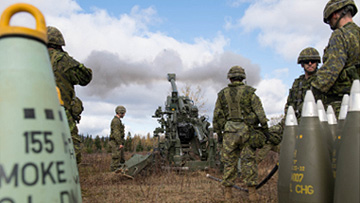 |
Minister Blair announces investments in Canadian innovation and launches Artificial Intelligence Strategy at Ottawa Conference on Security and DefenceMarch 7, 2024 Today, the Honourable Bill Blair, Minister of National Defence, delivered a keynote speech at the 92nd annual Ottawa Conference on Security and Defence and discussed Canada’s national defence priorities. |
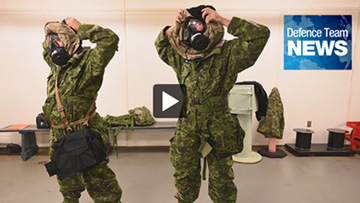 |
Defence Team News: DRDC helps military members breathe easier during trainingVideo / March 7, 2024 |
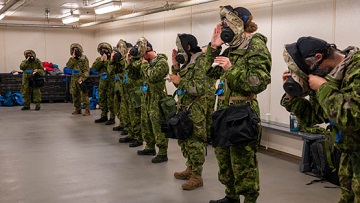 |
DRDC helps military members breathe easier during trainingMarch 1, 2024 Shaved skin used to be the only way to get a good seal and adequate respiratory protection wearing a gas mask, but research trials on a new respirator, called the C5B, promise a “breath of fresh air” during training drills for Canadian Armed Forces (CAF) members who have beards, long hair, headdresses or uniquely shaped faces. |
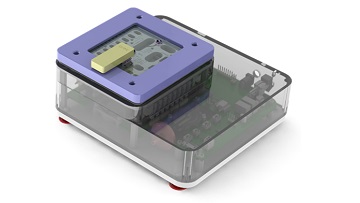 |
DRDC’s Centre for Security Science funds work on a portable platform for pathogen detectionFebruary 14, 2024 The first step of addressing any sickness is figuring out the cause. Whether its for treatment or to avoid spreading it, diagnoses are necessary for dealing with illness. |
 |
Former CAF member to act as bridge to Canadian innovation for the UkraineFebruary 13, 2024 When given the chance to serve her country and make a difference in the world, time and time again, Marie-Pierre Raymond has enthusiastically said yes. |
 |
Standardization is key to help militaries work together towards green futureFebruary 9, 2024 Defence scientist Inbal Marcovitch is working to ensure that standardization is part of the process as Canada and its allies work to rapidly adopt new green military technologies to respond to the climate crisis. |
 |
DRDC investigates augmented reality for improved mission planningFebruary 8, 2024 Augmented reality offers potential advantages for the Royal Canadian Navy (RCN) to be able to visualize in three dimensions the battlespace both above and below the surface of the water.24 |
 |
DRDC engineering group puts equipment to the test to simulate deep ocean conditionsFebruary 5, 2024 Alexandra McLeod, a mechanical engineering technologist and leader of the maritime information systems and technology (MIST) group at the DRDC Atlantic Research Centre, explains how they use a high-pressure tank to ensure underwater equipment can withstand the pressure of the ocean depths. |
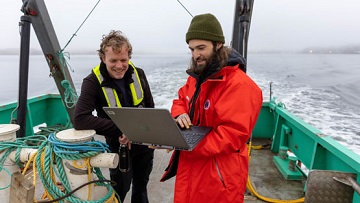 |
Dalhousie University student discovers new career interest during co-op term with DRDCJanuary 24, 2024 Dalhousie University electrical engineering student Tristan Batchelor describes his experiences during a co-op term with Defence Research and Development Canada's Atlantic Research Centre in the fall of 2023. |
 |
Bot or not? Defence scientists detect deception onlineJanuary 8, 2024 The internet is widely used as a tool for entertainment, to connect with friends and family, and to learn new skills. However, it can also be a battlespace, and just like on land, sea and in aerospace, it’s important that Canada is prepared to face threats online. |
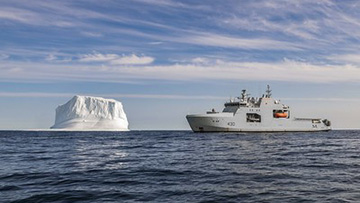 |
DRDC demonstrates commercial satellites can be used for Arctic surveillance during Op NANOOK – TUUGAALIK – NUNAKPUTDecember 20, 2023 Defence scientists with Defence Research and Development Canada (DRDC) experimented with commercial satellites in low earth orbit (LEO) for military intelligence, surveillance and reconnaissance (ISR) in the Arctic, during Operation NANOOK – TUUGAALIK – NUNAKPUT 2023. |
 |
Defence Team News: IDEaS Pop-up City Contest winner announced!December 14, 2023 We’re “greening” temporary military camps! The Innovation for Defence Excellence and Security program recently declared a winner in a contest to develop more efficient and environmentally sustainable energy, water, and waste management systems for our camps. |
 |
Minister Blair congratulates successful Canadian innovators in first NATO DIANA challengesDecember 8, 2023 As announced in 2022, NATO’s Defence Innovation Accelerator for the North Atlantic (DIANA) is coming to Canada, with its North American Regional Office finding a home in Halifax. |
 |
IDEaS program invests in identifying malicious actors onlineDecember 7, 2023 The Innovation for Defence Excellence and Security (IDEaS) program, working with the Canadian Special Operations Forces Command (CANSOFCOM), has completed its first ever Test Drive - on detecting and identifying online cyber threats. |
 |
Innovation Day showcases science and technology for first responders and climate resilienceDecember 4, 2023 The Canadian Safety and Security Program hosted an Innovation Day in Ottawa on Nov. 16, 2023, focused on science and technology to bridge capability gaps for the first |
 |
Minister Blair concludes 15th Halifax International Security ForumNovember 19, 2023 Today, the Honourable Bill Blair, Minister of National Defence, concluded his visit to Halifax, where he co-hosted the 15th annual Halifax International Security Forum (HISF) with HFX President Mr. Peter Van Praagh. |
 |
IDEaS Marketplace brings the defence innovation community togetherNovember 10, 2023 IDEaS Marketplace provides innovators with an opportunity to network, create partnerships, and display their unique solutions. |
 |
National Defence releases strategy to advance climate resilience and environmental sustainabilityNovember 7, 2023 The Department of National Defence (DND) and Canadian Armed Forces (CAF) released a strategy to improve its environmental sustainability and climate change resilience through our science, technology, and innovation research. |
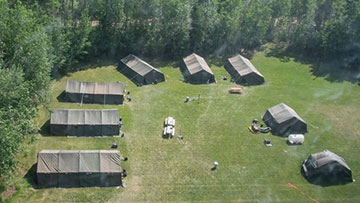 |
IDEaS invests in greening temporary camps for defence and beyondNovember 7, 2023 The Innovation for Defence Excellence and Security (IDEaS) program recently awarded a $2-million grand prize in the Pop up city contest, to build more efficient “green” energy, water and waste management solutions for camps used by the Canadian Armed Forces. |
 |
Canadian Armed Forces continues 10-year long effort in Counter-Explosive capability buildingNovember 2, 2023 Approximately 180 Canadian Armed Forces (CAF) members hosted nearly 150 members from partner nations for Exercise ARDENT DEFENDER, an international counter explosive exercise held at 5 Canadian Division Support Base Gagetown, New Brunswick, from October 20 to November 2, 2023. |
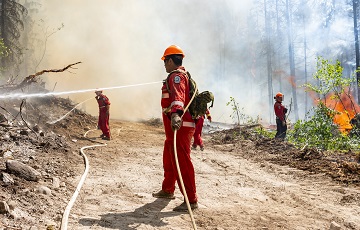 |
DRDC helps pave the path to understanding risk and resilience: Supporting Canada’s National Risk ProfileOctober 26, 2023 Wildland fires, pandemics, floods, and more – Canada is increasingly feeling the consequences of extreme disasters. |
 |
New funding available: Advanced analytics and decision support for first respondersOctober 11, 2023 The Canadian Safety and Security Program (CSSP) is looking to develop several research micro-nets to advance the application of promising artificial intelligence and machine learning technologies to support first responders. |
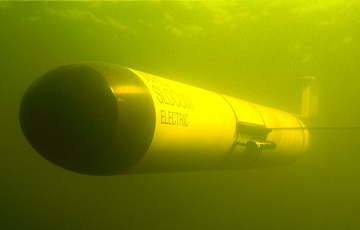 |
Securing the sea for Exercise CUTLASS FURY 2023September 25, 2023 It’s hard to find a place that can serve as both a training ground for military ships and aircraft, and as a home to sensitive wildlife. |
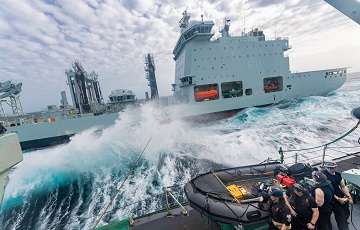 |
The future is electric – but what about Navy ships?September 22, 2023 With electric cars becoming increasingly popular, it’s easy to see how quickly electrification is taking a hold of the car market – but what about Navy ships? Defence Research and Development Canada (DRDC) is tackling that very question. |
 |
DRDC at DEFSEC AtlanticSeptember 21, 2023 DRDC staff are looking forward to connecting with current and potential partners in person at DEFSEC Atlantic from October 3 to 5, 2023 in Halifax, Nova Scotia. |
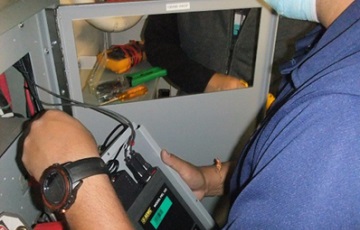 |
Going green in the Royal Canadian Navy: Full SPEED aheadSeptember 18, 2023 One of the best ways to increase energy efficiency is to map out how it is used and look for opportunities to cut back. |
 |
DRDC resuscitates life-saving blood product research for trauma patientsSeptember 11, 2023 A Second World War-era innovation is being revived by a team of researchers in Toronto, that will improve care for trauma patients and possibly save lives of Canadian Armed Forces (CAF) members who are in combat or in remote locations. |
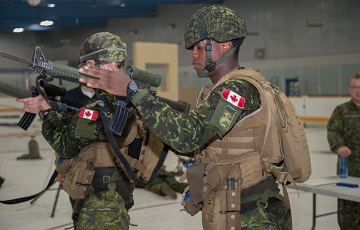 |
When it’s literally too hot in here: DRDC researchers investigate how to keep CAF members coolAugust 16, 2023 Coping with heat hasn’t been easy this summer. For many, it’s been finding air conditioning, gaining access to pools or some other means of cooling down. |
 |
DRDC tests early detection wildfire sensorsAugust 10, 2023 Millions of people worldwide can now recognize the burnt smell, the thick smoke, and the red haze of a fire burning kilometres away. With the effects of climate change increasing their number, frequency, and intensity, wildfires have spread across Canada at an unprecedented rate. |
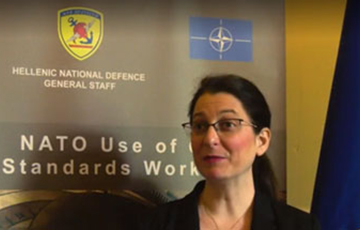 |
Anticipating emerging tech trends helps allies work togetherJuly 31, 2023 Foresight analyst sounds like a job where you might need a crystal ball to go along with your degree, but as Inbal Marcovitch, a defence scientist with the Department of National Defence’s science and technology organization, Defence Research and Development Canada, explains, her work is more practical than mystical. |
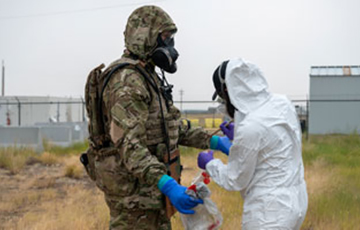 |
Exercise PRECISE RESPONSE 2023: Coordinating Common (De)Contamination ProceduresJuly 28, 2023 Testing chemical, biological, radiological, and nuclear (CBRN) technology is no easy feat – but it’s made easier with friends. That’s why Defence Research and Development Canada (DRDC) is getting military personnel and scientists from around the world to put on their protective suits and get their gloves dirty at Exercise PRECISE RESPONSE (EX PR) 2023. |
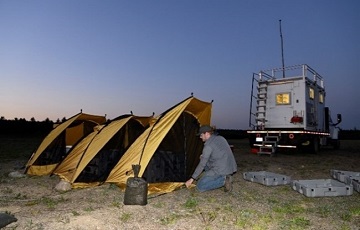 |
Navigation Warfare: Testing the World’s Most Advanced Military-Grade GPS SystemJuly 24, 2023 DRDC tested the most-advanced military GPS technology to date – a system that has the potential to improve mission effectiveness, reduce risks to personnel, and enhance operational efficiency. |
 |
Game on! DRDC analysts are serious about war gamesJune 26, 2023 Serious gaming may seem like an oxymoron, but war games are a valuable tool for the Canadian Forces and government departments to work through complex problems with limited resources and sometimes competing agendas. |
 |
Remote Threat Detection: DRDC tests the limits of sensors on drones in NATO trialJune 14, 2023 DRDC researchers worked with NATO partners to test sensors on drones to look for improvised explosive devices (IED), mines, and unexploded ordinance in six scenarios including buildings, power transmission towers, and roads. |
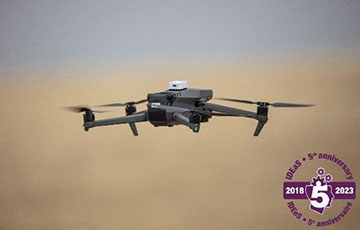 |
Innovation for Defence Excellence and Security program celebrates five years of transforming defence and security challenges into innovative solutionsJune 13, 2023 In April 2023, the Defence IDEaS program marked 5 years of advancing its goals of building a defence innovation community, finding solutions, and pushing technology forward. |
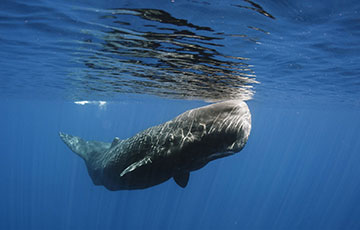 |
Marine Mammal Monitoring – Tracking whales with thermal cameras on dronesJune 8, 2023 The Marine Mammal Monitoring (M3) program, led by Defence Research and Development Canada (DRDC), is helping the Department of National Defence/Canadian Armed Forces (DND / CAF) understand, monitor, reduce and mitigate its impact on the marine environment. |
 |
DND/CAF publishes implementation plan for quantum S&T strategyMarch 27, 2023 The Department of National Defence and Canadian Armed Forces (DND/CAF) Quantum Science and Technology Strategy Implementation Plan, known as Quantum 2030, is a roadmap to ensuring DND/CAF is better prepared for the disruptive potential of quantum technologies for defence and security over the next seven years. |
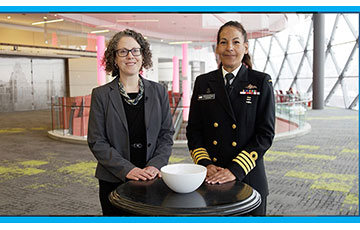 |
60 Seconds with Capt(N) Kelly Williamson and Christina Jutzi, Executive Committee members for Women in Defence and SecurityMarch 9, 2023 Join Capt(N) Kelly Williamson and Christina Jutzi, as they team up to take on the 60 seconds challenge. They discuss the work of Women in Defence and Security (WiDS), breaking glass ceilings, and who inspires them. |
 |
Minister Anand updates National Defence stakeholders on progress to modernize the Canadian Armed Forces for tomorrow’s security challengesMarch 9, 2023 Minister Anand also announced today that Canada has awarded a contract for the Redwing space domain awareness microsatellite project, valued at $15.8 million. |
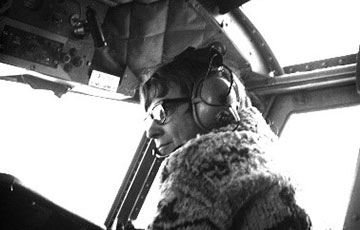 |
Moira Dunbar broke ground as first woman ice researcher in Canada’s High ArcticMarch 8, 2023 On International Women's Day, DRDC is celebrating the distinguished scientific career of the late Moira Dunbar, who was the first woman ice researcher in Canada's High Arctic in the 1950s and the first woman researcher to use airborne radar to study ice in Canada's High Arctic. |
 |
NEOSSat's 10th anniversary in orbitFebruary 24, 2023 We celebrate the 10th anniversary of the launch of the NEOSSat microsatellite, the world's first space telescope dedicated to detecting and tracking asteroids, comets, satellites, and space debris. |
 |
60 seconds with Magaly Obas Compton, Policy Lead, Quantum and Emerging Science and TechnologyFebruary 23, 2023 Meet Magaly Obas Compton, the quantum and emerging science and technology policy lead at Defence Research and Development Canada, as she takes on the 60 seconds challenge to discuss her fascinating work supporting this important area of research. |
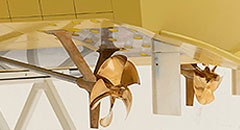 |
DRDC research helps the Canadian Armed Forces protect whales during operationsFebruary 16, 2023 Defence science and technology, led by Defence Research and Development Canada (DRDC), is helping the Canadian Armed Forces (CAF) understand, monitor, reduce and mitigate its impact on the marine environment. |
 |
Defence scientist working on collaborative green energy research projectsFebruary 7, 2023 The United Nations declared February 11 as the International Day of Women and Girls in Science in 2016 to encourage gender equality in science. This year, the international campaign is focusing on the role of women in advancing sustainable development goals including affordable and clean energy. |
 |
DRDC helps students and post graduates launch rewarding careersJanuary 24, 2023 On the International Day of Education, Defence Research and Development Canada is celebrating the contribution of students and post graduates to advancing science and technology for the Department of National Defence, Canadian Armed Forces, and public safety and security communities. |
 |
Register for the Defence Research and Development Canada outreach event on December 12, 2022November 30, 2022 DRDC invites you to its 2022 outreach event on Monday, December 12 from 1 to 3 p.m. ET. This two-hour virtual event will provide you with the information you need to build a successful partnership with Canada’s leading defence science organization. |
 |
Government of Canada proposes Halifax as North American location for NATO’s Defence Innovation Accelerator for the North AtlanticNovember 18, 2022 Minister of National Defence, Anita Anand, announced today that Canada is proposing the Halifax Regional Municipality, Nova Scotia, to host the North American Regional Office of the North Atlantic Treaty Organization’s (NATO) Defence Innovation Accelerator for the North Atlantic (DIANA). |
 |
DRDC-led team finishes first in international cyber security competitionOctober 17, 2022 - Defence Stories A team from Defence Research and Development Canada (DRDC) took home the gold medal in an international capture-the-flag cybersecurity competition on Aug. 16, 2022. |
 |
As part of Women’s History Month, DRDC highlights a scientist who continues to contribute to defence research and developmentOctober 28, 2022 October is Women’s History Month and to celebrate, Defence Research and Development Canada (DRDC) is highlighting defence scientist Hengameh Irandoust and her contribution to researching solutions for more effective human-autonomy teaming in command and control for the Canadian Armed Forces. |
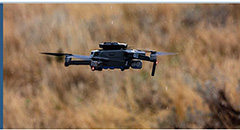 |
Defence Team News Interview with Major Raymond Green and Jared Giesbrecht on the Counter Uncrewed Aerial Systems - IDEaS SandboxVideo / October 12, 2022 Major Raymond Green and Defence Scientist Jared Giesbrecht discuss the recent IDEaS Sandbox event in Suffield, Alberta on Counter Uncrewed Aerial Systems, as the CAF looks to better understand and improve its capability in counter-drone measures and warfare. |
 |
DRDC celebrates math behind science and tech solutions for the CAF during Science Literacy WeekSeptember 23, 2022 From September 19 to 25, 2022 Science Literacy Week is being celebrated across Canada and this year’s theme is math as the language in which science is written. |
 |
CANSOFCOM leverages innovative talent to gain a competitive advantage over its adversariesSeptember 20, 2022 On September 16-18, thousands of university students participated in an annual event at the University of Waterloo called Hack the North, which provided opportunities for the students to solve various technology-related challenges and win prizes. |
 |
National Defence works with industry to protect marine mammalsApril 27, 2022 DND and the CAF are committed to environmental stewardship and mitigating the impact of active sonar on the marine environment. |
 |
DRDC is developing science and technology solutions to monitor and mitigate the impacts of active sonar on the marine environmentFebruary 20, 2022 The aim of this research is to give Canadian Armed Forces decision makers the real-time information they need to plan operations while protecting marine mammals. |
 |
Department of National Defence invests in innovative and efficient solutions for temporary military campsFebruary 16, 2022 The Department of National Defence announced today three contribution agreements with Canadian innovators to develop solutions to provide integrated energy, water and waste management systems for relocatable temporary camps (RTC) used by the Canadian Armed Forces. |
 |
Gazing into the COVID-19 crystal ball with Josée van den Hoogen, Defence ScientistFebruary 10, 2022 If the COVID-19 pandemic has taught us anything, it is that it’s hard to predict the future, but for Defence Research and Development Canada (DRDC) scientist Josée van den Hoogen that challenge is part of her job in operational research. |
 |
DT News interview: Mats Striegler on the Green Heat: Low Carbon Energy Generation for Heating Existing Buildings IDEaS challengeVideo / August 5, 2021 Mats Striegler joins us today to tell us more about the Green Heat: Low Carbon Energy Generation for Heating Existing Buildings challenge and what it means for Defence, Canada, energy consumption, and reduction of the global carbon footprint. |
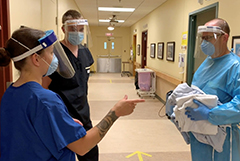 |
DT News: Defence Research and Development Canada supports COVID-19 responseVideo / July 23, 2021 Over the last year and a half, DRDC has supported the Canadian Armed Forces response to the COVID-19 pandemic with a variety of science and technology solutions. |
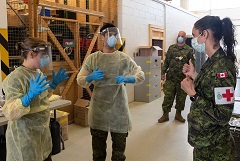 |
Defence research supports COVID-19 responseJuly 19, 2021 Defence Research and Development Canada scientists and researchers have rapidly changed focus to respond to various COVID-19 challenges. |
 |
Department of National Defence awards $54-million infrastructure greening contract in Nova ScotiaJuly 14, 2021 On June 21, 2021, the Department of National Defence awarded a new energy performance contract (EPC) to upgrade facilities at CFB Halifax, 12 Wing Shearwater, Canadian Forces Ammunition Depot (Bedford), and Defence and Research Development Canada (Atlantic). |
 |
Innovation for Defence Excellence and Security (IDEaS) Pop Up City contest pitch eventVideo / June 18, 2021 On March 23rd, innovators from across Canada vied for a chance at $1.5 million in Round 3 of the IDEaS Pop Up City contest. |
 |
Defence scientists bring creativity and innovation to science outreach - Canada.caMay 13, 2021 DRDC scientists and researchers are finding innovative ways to continue to talk to young people about careers in science, technology, engineering and math (STEM), despite COVID-19 restrictions. |
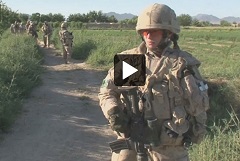 |
Minister of National Defence video message for International Women’s Day 2021Video / March 8, 2021 |
 |
Department of National Defence (DND) invests in Canadian solutions to COVID-19 challengesMarch 4, 2021 |
 |
60 Seconds with Donna Pickering from DRDC Toronto on International Day of Women and Girls in ScienceVideo / February 11, 2021 |
 |
Defence Team (DT) News interview: Defence Scientists for International Day of Women and Girls in ScienceVideo / February 10, 2021 |
 |
Defence scientists empower girls to pursue dreams in STEM through outreachFebruary 9, 2021 Women scientists from Defence Research and Development Canada are participating in outreach to encourage girls to pursue careers in STEM for the International Day of Women and Girls in Science on February 11. |
 |
DRDC sets AMAZE-ing goal to reduce Greenhouse Gas Emissions in Arctic facilitiesDecember 17, 2020 A team of researchers is aiming to make Arctic facilities more sustainable with the Defence Research and Development Canada (DRDC)-led project, Advanced Microgrids towards Arctic Zero Emissions (AMAZE), which was awarded $1.65 M over three years from the Greening Government Fund in June 2020. |
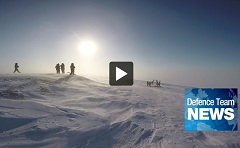 |
DT News interview: today we‘re speaking with Adrienne Turnbull for Arctic Science MonthVideo / December 11, 2020 |
 |
All Domain Situational Awareness Science and Technology ProgramVideo / December 7, 2020 |
 |
Government of Canada invests in new defence research facility in ValcartierNovember 26, 2020 |
 |
DND awards $2 million to two companies developing COVID-19 solutions and productsJuly 30, 2020 |
 |
DND launches a call to innovative thinkers for solutions to COVID-19 challengesMay 26, 2020 |
 |
Canadian Disruptive Pattern (CADPAT): A uniquely Canadian developmentMarch 13, 2020 |
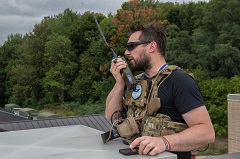 |
Contested Urban Environment 2018December 5, 2018 Defence science and technology advances result from collaboration between scientists and military. Innovations are born in the labs and then tested in relevant and realistic environments before being returned to the labs for further enhancements and, eventually, adopted by the military. |
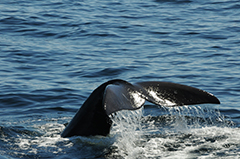 |
Defence Research and Development Canada leads a pan governmental experiment in whale preservationDecember 3, 2018 Two Ph. D candidates, Maj. Dugald Thomson (Defence Research and Development Canada) and Hansen Johnson (Dalhousie University) spearheaded an experiment to understand right whale behavior while testing new Royal Canadian Air Force (RCAF)’s monitoring and recognition software... |
 |
Supporting emergency management officials during the Fort McMurray wildfire responseMay 2, 2017 In May 2016, a wildfire began ravaging Fort McMurray and surrounding areas, leading to the evacuation of more than 80,000 residents. As first responders battled the blaze and emergency management officials worked tirelessly to coordinate efforts, several organizations, including Defence Research and Development Canada’s Centre for Security Science (DRDC CSS), worked behind the scene to provide advice and support... |
 |
Defence scientist was contender for spot as Canadian AstronautMarch 24, 2017 The Canadian Space Agency (CSA) is looking to recruit two new astronauts through its fourth astronaut recruitment campaign. Thomas Karakolis a defence scientist at Defence Research and Development Canada (DRDC) was hoping to be one of them... |
 |
Canadian and Australian experts run experiments at Shirleys BayMarch, 14 2017 For the first time, Canadian and Australian experts recently conducted joint electronic warfare targeting experiments at the Canadian Forces Warfare Centre (CFWC) in Shirleys Bay, Ottawa... |
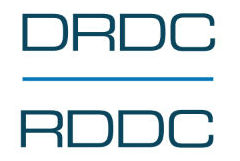 |
Statement - First workshop of the new Institute for Research in Defence and SecurityFebruary 27, 2017 Dr. Marc Fortin, ADM (Science and Technology) and CEO Defence Research and Development Canada, made the following statement... |
 |
Exercise ATHENA photo galleryFebruary 27, 2017 This train derailment exercise, known as Exercise Athéna, was held on 25-26 February, 2017, at the Institut Maritime du Québec in Lévis, Québec. Transport Canada (TC) hosted this event in partnership with Defence Research and Development Canada’s Centre for Security Science (DRDC CSS)... |
 |
Genetic sequencing could help diagnose PTSDJanuary 23, 2017 Defence research scientists are developing a study on how post-traumatic stress disorder (PTSD) may be linked to certain genes which may help with diagnosis and treatment. Every person has a particular set of genes that act like recipes for a variety of traits. Some human genes are different depending on the person. These are the genes that make us unique, determining everything from eye colour to height to brain chemistry. While genomics — the study of genes and what they do... |
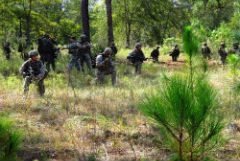 |
Canadian Army uses science to enhance multinational interoperabilityJanuary 18, 2017 The Canadian Army recently joined colleagues from 17 other partner nations to test and assess the interoperability of their various systems and networks... |
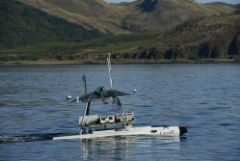 |
Exercise UNMANNED WARRIOR: an international exercise using autonomous tech to detect underwater minesDecember 13, 2016 The area surrounding Scotland’s Isle of Skye was speckled with ships, and unmanned vehicles in the sky, on the ocean’s surface and below it, all working together to detect and neutralize a minefield on the seafloor... |
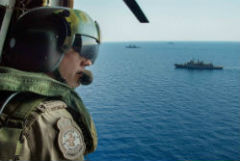 |
Neck pain research yields solutionsOctober 31, 2016 Neck pain is a common complaint among CH-146 Griffon helicopter pilots and flight engineers, and the Canadian Armed Forces (CAF) is looking for solutions to the problem... |
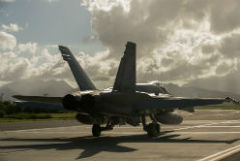 |
Defence researches audio warning in the cockpitOctober 26, 2016 When it comes to cockpit audio warnings, is the male or female voice more effective for getting the attention of pilots? This is something investigated by scientists at Defence Research and Development Canada (DRDC), Toronto Research Centre... |
 |
The Canada - U.S. Enhanced Resiliency Experiment IV (CAUSE IV) - Vignette 2October 25, 2016 Canada and the United States came together from April 26 to 28, 2016 to assess technologies that can help their respective emergency management officials and responders communicate and exchange information more efficiently during an emergency situation touching both sides of the border... |
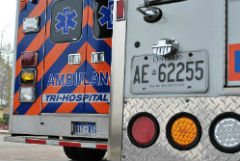 |
The Canada - U.S. Enhanced Resiliency Experiment IV (CAUSE IV) - Vignette 1October 25, 2016 Canada and the United States came together from April 26 to 28, 2016 to assess technologies that can help their respective emergency management officials and responders communicate and exchange information more efficiently during an emergency situation touching both sides of the border... |
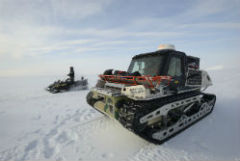 |
Extreme expedition: testing prototype vehicles in Canada's ArcticJuly 7, 2016 Operation NUNALIVUT proved an ideal circumstance for a Defence Research and Development Canada (DRDC) team to test prototype vehicles in the extreme environment of the high Arctic and during active Canadian Armed Forces (CAF) operations... |
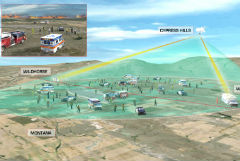 |
Wildfire disaster scenario: New report highlights how new communication technologies improve emergency responseJune 1, 2016 The Canada – United States (U.S.) border is the longest international border in the world, reaching almost 9,000 km. This poses major challenges when it comes to emergency response, including efficient cross-border sharing of information during emergencies that affect both countries... |
Multi-target tracker software enhances commercial radar productsMay 28, 2015 Software that enables radar to track multiple targets at the same time has been added to the sigma S6 radar product line developed by Rutter Inc., a Canadian company based in St. John’s, Newfoundland... |
|
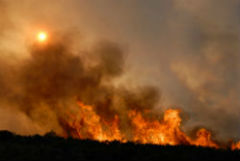 |
Where there's smoke there's fire: Researchers enhance forecasting system to better predict smoke patternsMay 19, 2015 The inhalation of wildfire smoke can have significant impacts on the health and safety of Canadians. It can aggravate pre- existing illnesses such as heart and lung disease and is particularly harmful to children and seniors. It can also cause uncomfortable symptoms such as coughing, breathing difficulties and irritated eyes... |
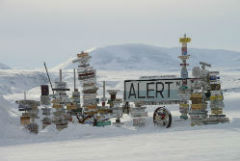 |
Spring 2015 geobuoy comparison trialMay 15, 2015 For roughly two weeks this spring from late April to early May a team of scientists, technologists and logistics support staff from Defence Research and Development Canada (DRDC) evaluated the performance of newly improved geobuoys on behalf of the Royal Canadian Air Force (RCAF)... |
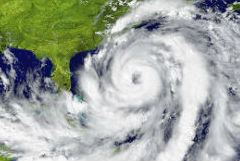 |
Tapping into social media and digital volunteers to improve disaster recovery operationsMay 7, 2015 A strong online presence was a key component allowing digital volunteers to help during recovery operations following a fictional Hurricane. These tech savvy individuals can work online from anywhere in the world, gathering and analysing social media data to provide a variety of information services to emergency professionals and government organizations during disasters... |
 |
A legacy of research in a harsh environmentApril 30, 2015 Alert, Nunavut sits at the northern tip of Ellesmere Island in Canada’s High Arctic. It is the most northern permanently inhabited location in the world. Defence Research and Development Canada (DRDC) has been conducting research at Alert and in the High Arctic for the past 60 years... |
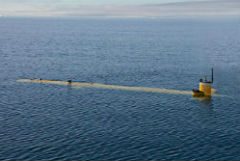 |
Searching uncharted Arctic waters for Franklin's lost shipsMarch 16, 2015 When modern-day Canadian explorers made what has been described as the discovery of the century by finding one of Sir John Franklin’s lost ships, defence scientists were honoured to be part of the 2014 Victoria Strait Expedition... |
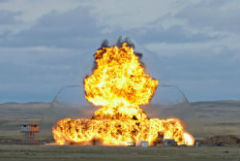 |
DRDC's experimental proving ground supports CAF, allied readinessMarch 10, 2015 Decontaminating a radiological source, responding to a natural disaster or deploying to the site of a suspected terrorist attack – these are just some of the activities that the Canadian Armed Forces (CAF) have to be prepared for... |
 |
Dr. Simona Verga: physicist, teammate, athlete and motherMarch 6, 2015 Since its inception in 2006, Dr. Simona Verga has been part of the hard working team at Defence Research and Development Canada. For seven years, she has worked as an Operations Research Analyst, providing decision support to internal and external clients through advice and guidance... |
 |
The evolution of the smart gunFebruary 9, 2015 More firepower, improved accuracy and smart integrated accessories that connect to command and control networks are the headline features of the new integrated assault rifle concept that Defence Research and Development Canada (DRDC) and Colt Canada have developed for the Canadian Armed Forces (CAF)... |
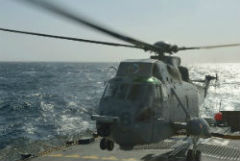 |
DRDC technology supports safer and smoother landings at sea for the Royal Canadian NavyDecember 1, 2014 Conducting helicopter operations from Royal Canadian Navy (RCN) ships is a complex and dangerous procedure requiring the highest degree of safety. Defence Research and Development Canada (DRDC) has developed a specialized system which has the potential to increase the safety of complex at-sea operations and ensure safer and smoother helicopter landings on RCN ships... |
 |
Retweet, like or share: How social media is changing the face of emergency managementNovember 3, 2014 It’s no longer unusual to learn about a severe weather warning or police manhunt through a “tweet” or a “wall post”. These words refer to common practices on Twitter and Facebook, but were not part of our vocabulary a decade ago. Today, whether it is for personal or professional reasons, the majority of Canadians are engaging with one another through social media websites every day... |
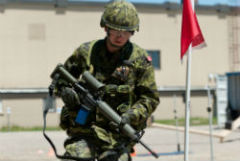 |
DRDC's CAN LEAP course an important tool in assessing soldier combat mobilitySeptember 30, 2014 Enemy threats and counter-insurgency operations have dramatically increased the focus on soldier personal protective equipment (PPE) and its critical role in ensuring survivability and mission outcomes... |
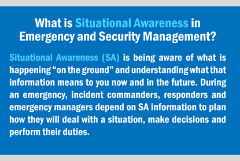 |
New portal instantly shares information between Government of Canada Operations CentresSeptember 24, 2014 Collaboration between different Government of Canada departments during significant events and emergencies is critical. As a situation unfolds, departments must be able to quickly track and manage information to help protect Canadians... |
 |
Tactical wearables and the self-organizing networkAugust 19, 2014 DRDC is conducting a series of trials to improve the performance and security of mobile ad hoc networks which aim to enable rapid decision making for dispersed operations. The first trial tested the tracking of a target on the move... |
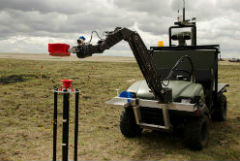 |
Keeping hazards at a robot arm's lengthJuly 11, 2014 A team of military responders hunker down behind sand bags, periodically peering over the top to watch a group of vehicles’ lights fade into the blackness of night. When the lights disappear entirely from their line of sight, the team’s focus quickly shifts back to the operator manning a control station... |
 |
DRDC: Science, Technology and Knowledge for Canada's Defence and SecurityOctober 17, 2013 |